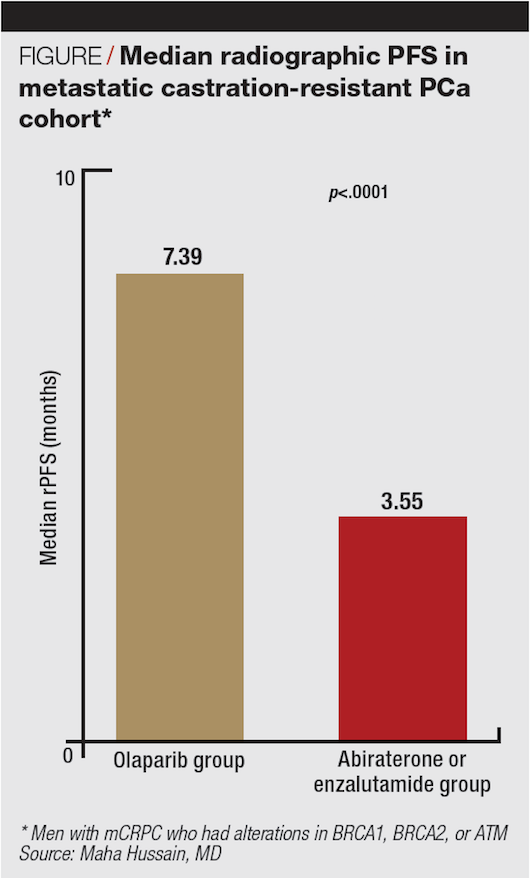Article
PARP inhibitor significantly extends rPFS vs. hormonal therapy
Author(s):
The PARP inhibitor olaparib significantly extended radiographic progression-free survival compared with physician’s choice of hormonal therapy in men with metastatic castration-resistant prostate cancer who had defects in genes involved in DNA repair mechanisms.
Barcelona, Spain-The PARP inhibitor olaparib (Lynparza) significantly extended radiographic progression-free survival (rPFS) compared with physician’s choice of hormonal therapy in men with metastatic castration-resistant prostate cancer (mCRPC) who had defects in genes involved in DNA repair mechanisms.

In the phase III PROfound study, olaparib improved median rPFS by about 4 months compared with physician’s choice of abirterarone (ZYTIGA) or enzalutamide (XTANDI) in men with mCRPC who had alterations in BRCA1, BRCA2, or ATM, reported Maha Hussain, MD, deputy director, Robert H. Lurie Comprehensive Cancer Center, Northwestern University, Chicago.
In this cohort, median rPFS was 7.39 months in those assigned to olaparib compared with 3.55 months in patients assigned to treatment with abiraterone or enzalutamide (HR 0.34; p<.0001).
In the overall study population, which included men with ≥1 alteration in any of 15 genes with a role in homologous recombination repair (HRR), median rPFS improved from 3.52 months in patients treated with hormonal therapy to 5.82 months in those treated with olaparib (HR 0.49; p<.001).
“Over the past 10 years, we have come to realize that mCRPC is a disease that can have deleterious alterations in a variety of genes. Some of these genes are involved in HRR. The intent is to target those types of genes to prevent the cancer cell from repairing itself,” said Dr. Hussain, who presented the findings at the European Society of Medical Oncology annual congress in Barcelona, Spain.
“PROfound is the first positive biomarker-selected phase III clinical study evaluating a molecularly targeted therapy in men with mCRPC, highlighting the importance of genomic testing in this population, and also importantly, highlighting the feasibility of precision medicine trial in this disease.”
Also see: Grant guides urologists on gaps in advanced PCa guidelines
PROfound randomized 386 men with mCRPC who had progressed on prior therapy with either or both hormonal agents in a 2:1 ratio to olaparib, 300 mg twice daily, with physician’s choice of enzalutamide, 160 mg/day, or abiraterone, 1,000 mg/day plus prednisone, 5 mg twice daily.
Two groups of men with mCRPC were enrolled. Men in cohort A had alterations in BRCA1, BRCA2, or ATM, and those in cohort B had alterations in any one of the 12 other genes known to be involved in DNA repair (BARD1, BRIP1, CDK12, CHEK1, CHEK2, FANCL, PALB2, PPP2R2A, RAD51B, RAD51C, RAD51D, or RAD54L).
Median patient age was about 68 years, with a maximum age of 91. Slightly less than one-fourth had metastatic disease at initial diagnosis. More than 60% had prior chemotherapy, and about one-fourth had two lines of prior chemotherapy.
The median duration of treatment was 7.4 months in the olaparib arm and 3.9 months in the hormonal therapy arm. Olaparib was associated with a higher rate of adverse events of any grade compared with hormonal therapy (95.3% vs. 87.7%).
Anemia (46.1 vs. 15.4%), nausea (41.4 vs. 19.2%), decreased appetite (30.1 vs. 17.7%), and fatigue (26.2 vs. 20.8%) were more common in the olaparib arm compared with the hormonal arm. Some 16.4% and 8.5% of patients, respectively, discontinued due to adverse events.
Next: Primary endpoint statistically, clinically significantPrimary endpoint statistically, clinically significant
“The primary endpoint [rPFS by blinded independent central review in cohort A] was not only statistically significant but clinically significant with separations of the [rPFS] curves occurring very early in the process and continuing to beyond a year,” said Dr. Hussain, translating into a 66% reduction in the risk of disease progression with assignment to olaparib versus hormonal therapy.

The confirmed objective response rate in cohort A was 33.3% in the olaparib arm and 2.3% in the hormonal therapy arm (OR 20.36; p<.0001). The time to pain progression also favored olaparib. The median time to pain progression was not reached in the olaparib arm compared with 9.92 months in the hormonal therapy arm (HR 0.44; p=.0192).
Read: Fusion transcript shows potential for prostate cancer biomarker
Overall survival (OS) data were not mature but in an interim analysis, median OS was 18.5 months with olaparib compared with 15.11 months with hormonal treatment (HR 0.64, p=.0173). Median OS in the overall population (cohorts A+B) was 17.51 vs. 14.26 months (HR 0.67, p=.0063 [nominal]), respectively.
AstraZeneca and Merck provided funding for the study.
Article idea? Contact the editors at urology_times@mmhgroup.com

















